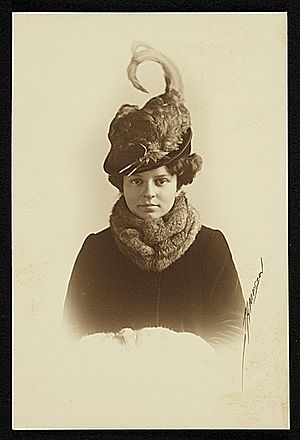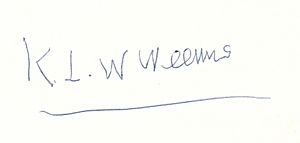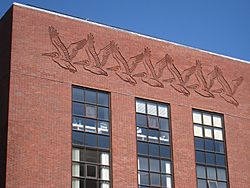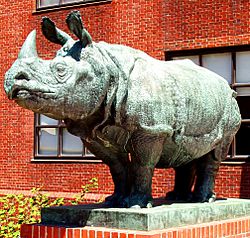Katharine Lane Weems facts for kids
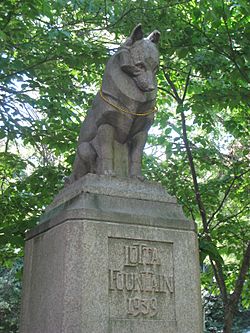
Katharine Lane Weems was an American sculptor known for her amazing and realistic sculptures of animals. She was born Katharine Ward Lane on February 22, 1899, and passed away on February 11, 1989.
Contents
About Katharine Lane Weems
Katharine Ward Lane was born in Boston on February 22, 1899. She was the only child of Gardiner Martin and Emma Louise Lane. Her family was wealthy, and she received a very good education, which was common for girls from rich families at that time. Her father was in charge of the Museum of Fine Arts, Boston, and her grandfather was a famous scholar named Basil Lanneau Gildersleeve.
Katharine studied art at the Boston Museum School. Her teachers included Charles Grafly and George Demetrios. She also learned from Anna Hyatt Huntington at her summer art studios. Even though she was very talented, Katharine, like many women artists back then, sometimes faced challenges because of her gender. Luckily, she got a lot of support from two important female artists, Anna Hyatt Huntington and Brenda Putnam.
In 1926, Katharine won two important awards: a Bronze Medal at the Philadelphia Sesquicentennial Exposition and the George D. Widener Memorial Gold Medal from the Pennsylvania Academy of the Fine Arts. Later, in 1960 and 1961, she received more awards for her sculptures.
Katharine created some famous public artworks. These include the large dolphin sculptures outside the New England Aquarium called Dolphins of the Sea (made in 1977). She also made the Lotta Fountain in Boston's Esplanade Plaza. She was a member of the Massachusetts Arts Commission from 1941 to 1947. Her sculptures can be seen in many places, including the Museum of Fine Arts, Boston and the Boston Athenæum.
Her Life and Family
In 1947, Katharine married Carrington Weems. After that, she sometimes used her maiden name, Katharine Ward Lane, and sometimes her married name, Katharine Lane Weems, for her art.
In 1961, she gave her family home at 53 Marlborough Street in Boston's Back Bay neighborhood to the French Library of Boston and Cambridge. This was a generous gift.
Katharine Lane Weems passed away in Rockport, Massachusetts, on February 11, 1989. Today, there is a special position at the Museum of Fine Arts in Boston named in her honor: the Katharine Lane Weems Curator of American Decorative Arts and Sculpture.
Katharine's Art at Harvard University
Katharine Lane Weems's sculptures are a big part of many public places in the Boston area. Her largest and most famous project was creating art for the Biological Laboratories at Harvard University. These labs were built in the early 1930s with a huge grant of $12 million from the Rockefeller Foundation. The university wanted the art to be as impressive as the new buildings, and Katharine was chosen for the job.
First, she designed and made the beautiful carved bronze doors at the entrance to the labs. This area is now called the Department of Molecular and Cellular Biology (MCB). Next, she created a series of friezes. These are long bands of sculptures that show more than 30 different kinds of wildlife. She used special drills to carve these animal images directly into the bricks at the top of the buildings. Katharine combined realistic animal details with the popular Art Deco style of the time. Many construction workers helped her with this huge project. The Great Depression was happening then, which meant that wages were lower, there were many workers available, and materials were cheaper. This made it possible to create such a grand art project.
To prepare for this big project, Katharine studied animals at the Bronx Zoo in New York City. She also looked at how artists in Japan and China showed animals, especially those found on ancient Han Dynasty tombs. She had also studied how ancient Egyptian and Indian artists presented animals.
The Famous Rhinos: Bessie and Victoria
The third part of the Harvard Biological Laboratories project became the most popular: two huge rhinoceros sculptures named Bessie and Victoria. These amazing sculptures are made of bronze and each weighs 3 tons! They are displayed in the courtyard of the MCB building. Katharine worked on Bessie and Victoria for five years. They were finally shown to the public on May 12, 1937.
From 2003 to 2005, the rhinos were moved out of the courtyard. This was done to protect them from any damage during the construction of Harvard's new mouse laboratory.
On May 11, 2007, the Department of Molecular and Cellular Biology held a special birthday celebration for Bessie and Victoria. Famous speakers like E. O. Wilson and John Woodland Hastings were there. For the party, the two rhino sculptures were even decorated with makeup, jewelry, and skirts!
Awards and Special Recognitions
- 1926: Bronze Medal at the Philadelphia Sesquicentennial Exposition
- 1926: Widener Medal at the Pennsylvania Academy of the Fine Arts
- 1965: A permanent gallery was created at the Boston Museum of Science to show her small animal bronzes.
- 1987: The Katharine Lane Weems Chair in Decorative Arts was created at the Museum of Fine Arts in Boston.
Where to See Her Art
You can find Katharine Lane Weems's sculptures in many important collections, including:
- Museum of Fine Arts, Boston
- Brookgreen Gardens in South Carolina
- The Pennsylvania Academy
- The Baltimore Museum
- Museum of Science, Boston
- Boston Athenæum
- Archives of American Art at the Smithsonian Institution
Public Sculptures
Here are some of Katharine Lane Weems's public artworks:
- Dolphins of the Sea (1977) at the New England Aquarium in Boston.
- Lotta Fountain (1939) at the Charles River Esplanade in Boston.
- Animal friezes at Harvard University's Department of Molecular and Cellular Biology buildings.


